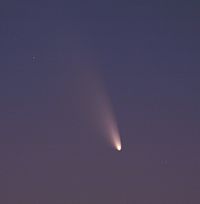Comet PANSTARRS

Image of Comet PanSTARRS by Gingin Observatory
|
|
| Discovery | |
|---|---|
| Discovered by | Pan-STARRS |
| Discovery date | 6 June 2011 |
| Orbital characteristics A | |
| Epoch | 20 Mar 2012 (JD 2456006.5) |
| Aphelion | Unknown |
| Perihelion | 0.30161 AU (q) |
| Semi-major axis | Unknown |
| Eccentricity | 1.000087 |
| Orbital period | ~106,000 yr (Barycentric solution for epoch 2050) |
| Inclination | 84.199° |
| Last perihelion | 10 March 2013 |
| Next perihelion | Unknown |
C/2011 L4 (PANSTARRS) is a non-periodic comet discovered in June 2011 that became visible to the naked eye when it was near perihelion in March 2013. It was discovered using the Pan-STARRS telescope located near the summit of Haleakalā, on the island of Maui in Hawaii. Comet C/2011 L4 probably took millions of years to come from the Oort cloud. After leaving the planetary region of the Solar System, the post-perihelion orbital period (epoch 2050) is estimated to be roughly 106000 years. Dust and gas production suggests the comet nucleus is roughly 1 kilometer (0.62 mi) in diameter.
Comet C/2011 L4 was still 7.9 AU from the Sun with an apparent magnitude of 19 when it was discovered in June 2011. By early May 2012, it had brightened to magnitude 13.5, and could be seen visually when using a large amateur telescope from a dark site. As of October 2012, the coma (expanding tenuous dust atmosphere) was estimated to be about 120,000 kilometers (75,000 miles) in diameter. C/2011 L4 was spotted without optical aid on 7 February 2013 at a magnitude of ~6. Comet PANSTARRS was visible from both hemispheres in the first weeks of March, and passed closest to Earth on 5 March 2013 at a distance of 1.09 AU. It came to perihelion (closest approach to the Sun) on 10 March 2013. Original estimates predicted that C/2011 L4 would brighten to roughly apparent magnitude 0 (roughly the brightness of Alpha Centauri A or Vega). An estimate in October 2012 predicted that it might brighten to magnitude −4 (roughly equivalent to Venus). In January 2013 there was a noticeable brightening slowdown that suggested that it may only brighten to magnitude +1. During February the brightness curve showed a further slowdown suggesting a perihelion magnitude of around +2.
...
Wikipedia
